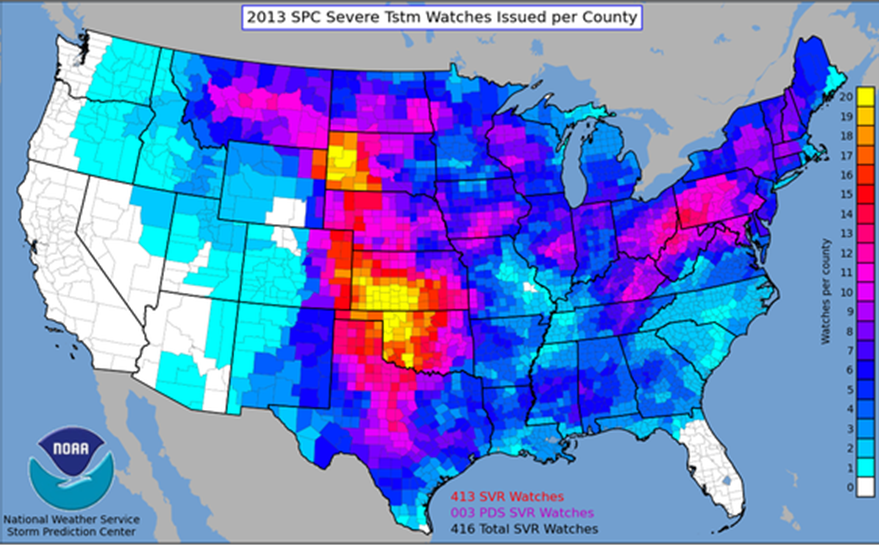
Severe thunderstorm watches issued by county, United States, 2013. Source: NOAA NWS Storm Prediction Center at http://www.spc.noaa.gov/wcm/.
Severe Thunderstorms
Thunderstorms are common occurrences in the Midwest and Central United States. Each year, an estimated 100,000 thunderstorms occur in the United States. Of those, about 10 percent are classified as severe thunderstorms - those that produce hail at least three-quarters of an inch in diameter, have winds of 58 miles per hour or higher, or produce a tornado.
All thunderstorms are dangerous and can be associated with a number of hazards. Heavy rains can lead to flash flooding events – one of the primary causes of death associated with thunderstorms. Lightning, which is produced by every thunderstorm, causes an average of 80 fatalities and 300 injuries each year. Lightning can also start building fires, damage electrical equipment, electrocute humans and livestock, and is the leading cause of farm fires. High winds generated by thunderstorm can cause damage to homes, overturn vehicles, uproot or damage trees, or blow down utility poles causing wide spread power outages. Hail causes billions of dollars in damage to crops and property each year and can injure people or animals left outdoors.
The following resources will help you prepare your family, home and farm, animals and business for severe thunderstorm situations.
Severe Thunderstorms Preparedness Factsheets
|
• Severe Thunderstorms and Your Family (pdf, 1 page) • More Family Resources |
|
|
• Severe Thunderstorms and Your Home (pdf, 1 page) • More Home Resources |
|
|
• Severe Thunderstorms and Your Pets (pdf, 1 page) • Severe Thunderstorms and Your Livestock (pdf, 1 page) • More Pet and Livestock Resources |
|
|
• Severe Thunderstorms and Your Farm (pdf, 1 page) • More Farm Resources |
|
|
• Severe Thunderstorms and Your Crops (pdf, 1 page) • More Crop Resources |
|
|
• Severe Thunderstorms and Your Business (pdf, 1 page) • More Business Resources |
Additional Web Resources
Website with lightning safety tips, first aid recommendations, and prevention measures.
Centers for Disease Control and Prevention (CDC)
Website to monitor severe storms and weather in your area.
National Weather Service
Factsheet discussing general information on tornadoes, lightning, wind, floods and hail.
National Weather Service (NOAA NWS)
Website discussing the impact of summer thunderstorms on corn yield
The University of Vermont






